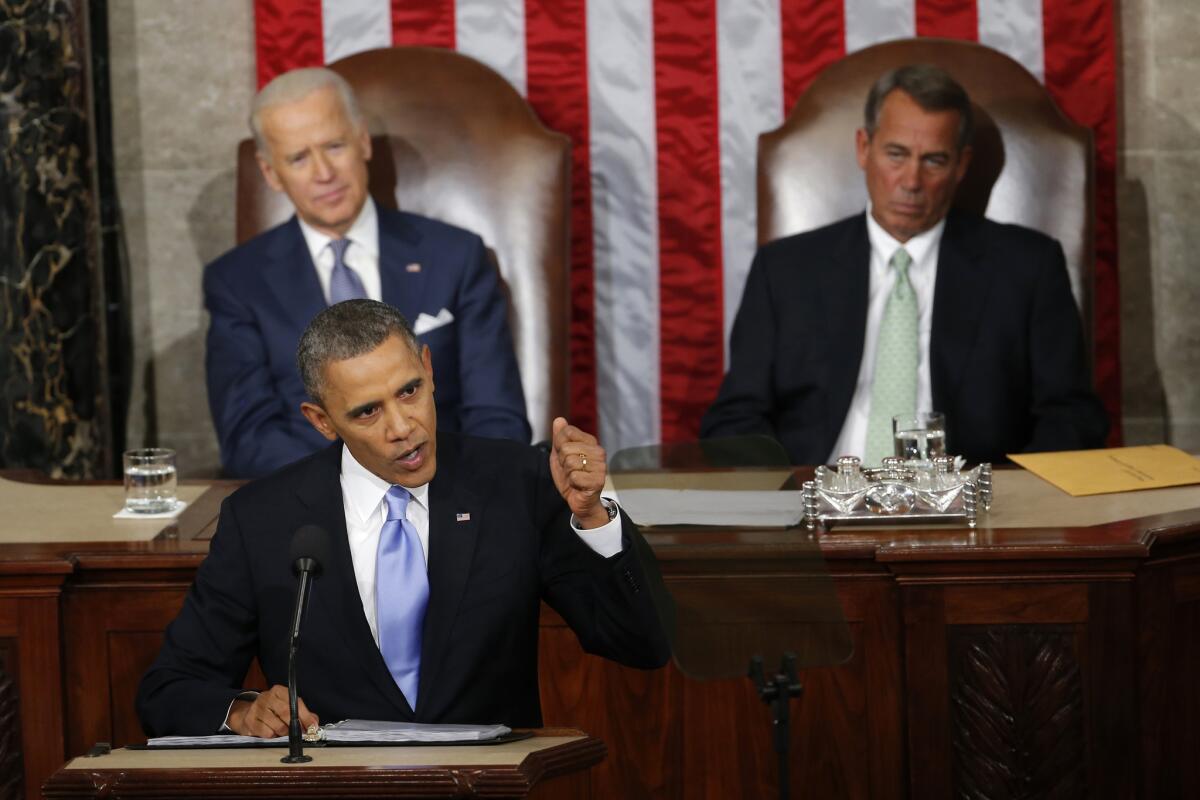Obama team tailors State of the Union for age of Twitter and YouTube

- Share via
Reporting from Washington — As President Obama worked on his State of the Union address last week, his staff sent out an email blast to ask the public what should be in it. The White House hyped nearly every recent major policy announcement — on LinkedIn and other websites.
After Obama delivers his vision for the country Tuesday, he’ll underscore the message through interviews — with a teen style guru, a video blogging nerd and a green-lipstick-wearing comedian who says she’s ready because she’s watched “Veep.”
They are YouTube stars.
The State of the Union address is a century-old tradition that has served to set the president’s agenda for the coming year and reflect on the previous one in front of Congress and the country, but in 2015, just giving a speech in prime time is no longer enough. The platform that introduced to the world the Four Freedoms and the War on Poverty is now a Twitter-friendly, YouTube-able event to be consumed in as many ways as Americans have screens.
The current state of the State of the Union is either the handiwork or the fault of the Obama White House, depending on your point of view.
This White House believes it brought the civic ritual into the social age, adapting as necessary to keep it relevant. Others say the speech, as an annual American moment, is going the way of the fireside chat.
“Social media is killing the State of the Union,” said presidential historian Allan Lichtman, “and the White House is doing everything it can to use social media to keep it alive.”
Of course, Americans’ shifting media diet isn’t only diminishing the State of the Union. Television’s audience is ever-fracturing, with the Super Bowl remaining as one of the only widely consumed televised events.
Still, the ratings for the speech are stark.
Viewership has been on a slide for decades, hitting the lowest point last year since President Clinton’s final State of the Union address in 2000. Obama’s own high point for his annual address to Congress was in 2009, five weeks into his first term, when he got more than 52 million viewers. About 33 million watched last year, the second lowest total of viewers the speech saw since the Nielsen ratings started tracking presidential speeches in 1993, when 67 million tuned in to watch Clinton address Congress about a month after his inauguration.
The White House says its solution is to find the missing 30-some-million television viewers wherever they are. That means producing an “enhanced version” of the speech to run online or for mobile devices. (The enhancement is a split-screen that juxtaposes the president at the lectern with charts backing up his assertions or photos of hardworking, sympathetic Americans.)
For those watching on television as well as monitoring their social media feeds, the White House will tweet and post to Facebook with similar material. For those not watching at all, the White House will repackage it all and feed it to your inbox, probably based on your specific interests.
“Our goal is to make so that you can consume the State of the Union wherever you want, whenever you want,” said White House senior advisor Dan Pfeiffer.
Pfeiffer said 1.4 million people watched Obama’s 2014 speech at WhiteHouse.gov, and 30% of visits to the site’s State of the Union page were from mobile devices — triple the share from 2012.
Though much of this self-produced programming isn’t new for this White House, the question of the speech’s future emerged this year in response to one new strategic choice. After years of trying to build suspense — at least in Washington — for what will be in the speech, the White House this year decided to burst the balloon.
Obama began announcing his key policy proposals two weeks ago — lower mortgage insurance rates, free community college, new consumer protections, a paid leave plan, and new financing for infrastructure projects — as well as major themes.
The preview was partly an effort to garner attention for administration initiatives over several days, rather than announce them all at once and have them forgotten a day or two later when public attention has moved on, said one White House staffer.
It was also an effort to assert the president’s relevance. The policy blitz began just as Republicans took control of the Senate and began outlining their agenda for the new GOP-majority Congress. The White House was happy to have the president counter with his own to-do list, even if much of it was wonky, wishful thinking.
Michael Waldman, chief speechwriter in the Clinton White House, notes this too was not entirely new. The Clinton team liked to leak key policy plans to journalists to spread out the news, he said. In fact, changing the speech to fit the media moment and the man has been a well-used presidential prerogative, he said.
Thomas Jefferson sent his constitutionally required report on the state of the nation in writing because he was shy and thought big, grand speechmaking looked “kingly,” Waldman said. For more than 110 years, the low-key method stuck.
In the age of radio, the in-person delivery made a comeback. President Reagan added a lasting dash of camera-ready showmanship by starting the tradition of inviting ordinary “heroes” to sit with the first lady in the gallery.
Waldman, now the president of Brennan Center for Justice at New York University Law School, said he thinks talk of the demise of the speech is exaggerated.
“The public is still hungry to hear from their leaders directly about what direction they want to take the country,” he said. “Thirty million people sitting through an hourlong speech on public policy? In this day and age, when they can choose to go on Netflix or cable or all the other choices, that is a huge thing.”
The White House maintains that all its State of the Union additions for the Web don’t change the content of the speech itself. Along with the drafting of the budget, writing the address still helps focus the president’s priorities and message, at least for as long as events allow.
It still gives interest groups and agencies a forum to plug their pet policies. It is still written and rewritten for weeks, and won’t be finished, aides say, until hours before the cameras roll.
The Obama team’s 21st century approach does change the way some in the White House hear the speech.
“You still need to write a coherent speech that tells a story about where the country is and where it’s going. And you still need to have good solid policy that supports that story. That’s all still true,” Pfeiffer said.
“But as we go through, now I read it differently than I would have read it five years ago. I’m reading it looking for the moments that you believe people will want to share on their social networks that will get traction on Twitter or Facebook or some other site.”
It’s hard to see future White House advisors listening much differently — as long as more Americans continue to consume their news through more and more sources. But it’s all but certain the next president will have to look to a different set of online communication tools and a different cast of YouTube celebrities to carry the message.
kathleen.hennessey@latimes.com
Twitter: @khennessey, @cparsons
More to Read
Get the L.A. Times Politics newsletter
Deeply reported insights into legislation, politics and policy from Sacramento, Washington and beyond. In your inbox twice per week.
You may occasionally receive promotional content from the Los Angeles Times.












